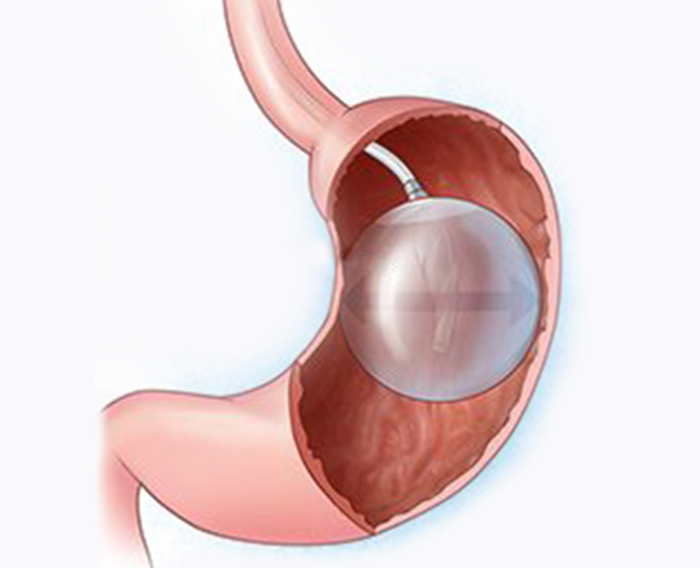
Intragastrični balon
Gastric Balloon in Turkey system consists of a soft, expandable balloon, a placement tube and a filling system. Intragastric balloon is too big to pass into the gut and leads to a relatively long-term feeling of fullness with smaller food portions. In general, intragastric balloon placement significantly reduces portion sizes and helps you to achieve your long-term weight loss goals.
How is an ingastric balloon placed into the stomach?
The balloon is endoscopically inserted into the stomach. The procedure takes about 20 to 25 minutes. First, a diagnostic endoscopy is performed to ensure that you do not have any medical condition that may prevent the placement of the balloon (such as an ulcer). If no abnormality is observed, a soft, deflated balloon made of silicone elastomer-based material is placed into the stomach. Once the balloon is placed into your stomach, it is filled with a blue liquid via a filling tube (catheter) attached to the balloon and the procedure is completed. The balloon starts floating freely within the stomach.
The procedure is performed under sedation to ensure patient comfort and the patient is awakened immediately after the procedure and is discharged from the hospital after a 2- hour observation period in the ward.
How Does an Intragastric Balloon Work?
As in the case of gastric banding, gastric balloon is a completely restrictive procedure that restricts the amount of food a patient can eat before feeling full, without causing any complications, such as poor absorption or malnutrition, as in some other bariatric procedures used to treat obesity.
Who is eligible for an intragastric balloon?
Intragastric balloon is an adjunctive method designed to help weight loss with diet. Overweight people with a body mass index higher than 25 kg/m², who have a prior history of failed attempts of losing weight with diet and exercises, who lost their motivation to diet or do not prefer surgical interventions are eligible for intragastric balloon placement. In addition, this procedure may be beneficial particularly for those who are considered to be too overweight to undergo major surgeries. The use of the balloon to lose weight before a major surgery may help reducing surgical risks associated with overweight
What are the advantages of an intragastric balloon?
The gastric balloon placement is a minimally invasive, non-surgical and outpatient procedure and those are also the main advantages of the procedure.
Long-term weight loss may occur once the patient adopts healthy eating habits. Long-term weight loss may improve already existing health conditions such as obesity- associated diabetes, hypertension and sleep apnoea and promotes self-esteem and self-respect.
What are the side effects associated with intragastric balloon?
Some of the side effects that can occur after intragastric balloon placement are nausea, and sometimes vomiting, gastroesophageal reflux disease, or balloon intolerance. In some patients, the balloon can leak, and this can lead to faster shrinkage of the balloon.
To address the balloon leaking problem, the balloon is often filled with a saline solution that contains a blue dye, when the urine changes to blue or sometimes to green, this shows that there is a balloon leak, and you need to see the doctor to remove it before it can slide into the small intestine.
The problem of balloon leak has been solved with the new generation of intragastric balloons, as a new kind of stomach balloons, called ReShape, has emerged, which is a dual balloon system, meaning that if one of the two leaks, the other balloon remains intact to prevent any complications.
What are the risks of an intragastric balloon?
Intragastric balloons are safely used worldwide in individuals with obesity or overweight. Complications are very rare and may be easily treated. Nausea, vomiting and cramps may occur during the first 2 or 3 days after the placement of the balloon. Certain medications are prescribed prior to hospital discharge to prevent such complications from occurring. Such symptoms disappear after the first 2 or 3 days.
The risk for a balloon rupture is not something like the term suggests. Actually, the balloon does not rupture; however, the liquid inside the balloon may leak. The leak and deflation of the balloon may be easily detected by the blue colour of the urine as the balloon is inflated with methylene blue. If you notice such colour change, please contact your doctor immediately for the balloon to be checked endoscopically and removed if necessary.
Is having an ingastric balloon in Turkey safe?
Gastric balloon surgery is the simplest obesity surgery. But although it is simple, it is very important for the patient’s health to perform the operation safely. Because the material used in the operation, the experience of the surgeon and the hygiene of the clinic affect the operation. Gastric balloon surgery in Turkey will be your most reliable choice in this sense. If you are looking for a cheap, safe and comfortable country, Turkey is ideal for you. It is a country with very successful references on Gastric balloon. You can read the comments of patients who have had this surgery in Turkey before on the internet. In a few days, you can have the operation safely and return to your country in a healthy way. Of course, for this reason, it is the right decision for you to have this operation in Turkey.
What is the cost of an ingastric balloon in Turkey?
Gastric balloons are cheaper in Turkey than in most European Countries and the US. The cost of a gastric balloon in the UK, for instance, is around £4000-£8000. US prices start from $6000-$10000, but Turkey’s prices are much lower than that. Turkey’s average gastric balloon price is £1999.
Why is Gastric Balloon Surgery Cheap in Turkey?
Stats in 2020 shows Turkey to be the most popular country in all kinds of cosmetic procedures, and it is easier to obtain gastric balloons in Turkey, at a cheaper cost, simply because average wages in the US or the UK and Europe play a major role in what can really be called ‘low cost’ here in Turkey
Are intragastric balloons painful?
In the first 48 hours the gastric balloon can irritate the muscle of the stomach wall causing griping pains. This usually settles over the first few days and a liquid diet can help minimise these symptoms.
What is weight Loss after an Intragastric Balloon like?
Weight loss in the patient group in which balloon was placed was 7% of body weight over a short period, compared to about 3% in the other group. Intragastric balloon group was assessed after two years of the intervention to find that they had lost 25% of their weight. Other statistical studies reported 33% of excess weight loss in patients treated with intragastric balloon
Is an intragastric balloon covered by insurance?
An intragastric balloon may be an option for you if: Your body mass index (BMI) is between 30 and 40. You’re willing to commit to healthy lifestyle changes, get regular medical follow-up and participate in behavioural therapy. You have not had any previous stomach or oesophageal surgery
Opening Hours


